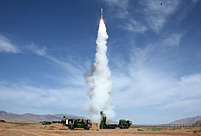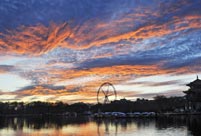 |
| (Yunnan.cn) |
Xishuangbanna Tropical Botanical Garden (XTBG) of Chinese Academy of Sciences (CAS) was established in 1950s by Chinese famous botanist Prof. Cai Xitao. The garden boasts more than 3000 species of tropical plants covering an area of 900 hectares, quite a few of which are rare elsewhere, forming a colorful botanical landscape. Twelve special sections are set up to grow plants separately and more than 100 major plants protected by the state are planted here.
In the park there are thirteen special sections for plant growing: the tropic fruit tree section, the shade-growing plant section, the palm plant section, the water plant section, the national plant section, medicinal plant section, kapur plant section, the spiceberry section, the bamboo section, the rare plant section, the banyan section, the famous flower and tree section.
The trees in the Tropical Botanical Garden are luxuriantly green and characterizing a spring day all the year round.What is particularly worth mentioning is that, in the comparatively well-protected 90 hectares of rain forests, there are altogether more than 2000 local plant species, which account for 40% of the plants in Xishuangbanna. Moreover, the botanical garden also transplants more than 400 varieties of plants of South Yunnan and 56 varieties of key national protection plants in this garden. These plants and animals together make the garden become an important base for botanical research, plant seed resource preservation, technical development, and science popularization; besides, the valleys and trenches here transverses in lengths and breadth and make the biotope particularly complex, and gives the botanical garden peculiar rain forest features. The visitors are more often than not relaxed and happy after taking a walk around this beautiful place.
Occupying an area of 0.8 ha, the Distinctive Plant Collection is home to 256 kinds of tropical rare and exotic flowers and trees. In this garden, visitors can have a taste at the "miracle fruit" (Synsepaium dulcificum) which can turn your taste and feel sourness as sweetness. You can also see "dancing grass" (Codariocalyx motorius) that is very sensitive to certain voice, and, mimosa grass (Mimosa pudica) and tree (Mimosa pigra), whose leaves will droop and shut when touched. Many other rare flowers are also vying for attraction, such as medicinal "mountain tortoise" (Stephania cepharantha) which tubers are spheroidal to obovate spheroidal in shape, pony tail palm (Cordyline fruticosa, elephant's foot), and Buddha belly plant (Jatropha podagrica) with swollen base, sorrowless tree (Saraca indica) and jackfruit (Artocarpus heterophylla) hick blossom and bear fruit.
Walk along the "air corridor" in the tall trees and one can get a bird's view of the entire forest and enjoy the head-on wind, fresh and cool. In the tropic fruit wood, you can taste the famous delicious Mansailong pomelo and Menglun jujube and other mysterious fruits .
Colorful tropical plants and beautiful natural views, pure and clean air, an annual average temperature of 21.5 degrees Celsius, all of these mentioned above make this place a wonderful winter resort. Fogs make you feel like in a paradise; nature wonders take people's breath away; Luosuo River passes through like a jade belt…Here you feel you are close to nature; you feel the harmony between man and nature, and you feel you are in a paradise.
The CAS Public Science Day, National Science and Technology Week, International "Fascination of Plants" Day, and International Biodiversity Day all fall in May. To celebrate these days, popular science activities are organized.
Here are a few popular science activities available in XTBG in May:
Activity 1: A popular science lecture was given in the local primary school on May 9;
Activity 2: A popular science exhibition themed with "plant and life" is going on;
Activity 3: XTBG opens its doors to local middle school students on CAS public science day and international "fascination of plants" day (May 18);
Activity 4: guided tours by XTBG director and some professors on International Biodiversity Day (May 22).
XTBG is one of the designated institutions to undertake environmental education to the public. Being a A class tourist destination in China, each year XTBG attracts a considerable number of tourists with anxious desire to capture knowledge on plants and environment.
All the 70 tour guides are recruited from local villages; most of them are ethnic minorities. After professional training, they could act as the "ambassadresses" of the Garden, while delivering scientific messages to visitors.
The visitor center, villa style hotels, swimming pools and other tourism facilities in this area make it an all-around recreational resort. Whether you come here for sightseeing, filed trip or business trip, you can escape from the noisy city and enjoy the peacefulness.
Transportation To Xishuangbanna
Xishuangbanna Dai Autonomous Prefecture is located in southwest Yunnan Province, and Jinghong city is the capital city. With the booming tourism in Yunnan, traveling to Xishuangbanna is much easier now. Jinghong is the transportation hub and travel base for tourists.
Air
Five kilometers away from Jinghong City, Xishuangbanna Airport is the second air harbor in Yunnan, just next below Kunming Airport. Since its opening from 1990, the airport's domestic service has covered major cities such as Kunming, Dali, Lijiang, Shanghai, Zhengzhou, Tianjin, Chengdu and Chongqing; its international service include Bangkok, Chiang Mai and Luang Prabang. The flight time of non-stop flight from Kunming to Xishuangbanna is about 50 minutes.
Highway
Xishuangbanna is 550km away from Kunming, and it takes 9 hours for the whole journey from Kunming to Bannan via expressway. Visitors can take the coach at the Long-distance Passengers station, Nanyao Coach Station and New Southern Passenger Station which are nearby Kunming Railway Station; more than 20 sleeper coaches and expresses depart to Jinghong.
The road traffic network in Xishuangbanna is very convenient, 213 and 214 national roads meet in Jinghong, roads reach to Mengla, Lancang and other places in the prefecture. When arriving in Jinghong, you can go to any scenic spot by taking the bus at any passenger station and Xishuangbanna passenger transport station.
Waterway
"Lancang-Mekong" is the sixth long river in the world, flowing across six countries, and known as the "Oriental Danube", it's a famous international waterway. Jinghong Port is a national harbor made up of three docks of Jinghong, Ganlanba and Guanlei. Jinghong port is for waterway, and has opened water transport routes to Chiang Saen, Thailand and Luang Prabang, Laos.
Taboo
No snooping on the bedroom
No striding over the oven on the floor
Don’t feel the head of the little monks
Take off your shoes before entering the temple
Location: Menglun Town, Mengla County, Xishuangbanna Prefecture
Tel: 0691-8715071
Transportation: take bus or taxi
Opening Hours: 8:00-18:00
Admission Fee: CNY 80
Free tickets available for: children shorter than 1.2 meters, elder people older than 70, the disabled, servicemen (relevant document is needed)
Cheaper tickets for: students (who has a student card), children taller than 1.2 meters, elder people aged 60-69 (preferential card is needed)
 National Plug In Day celebrated in Washington D.C.
National Plug In Day celebrated in Washington D.C. New model of indigenous surface-to-air missiles testfired
New model of indigenous surface-to-air missiles testfired  118.28-carat diamond to be auctioned in HK
118.28-carat diamond to be auctioned in HK Maternal love under streetlight
Maternal love under streetlight Naked foreign student sits in the middle of a road in Haikou
Naked foreign student sits in the middle of a road in Haikou  Colorful Yunnan: Enjoy the natural beauty
Colorful Yunnan: Enjoy the natural beauty Harbin named Chinese city with most beautiful women
Harbin named Chinese city with most beautiful women For last four students, teacher couple sticks to post on island
For last four students, teacher couple sticks to post on island  When big sport stars were kids
When big sport stars were kids PLA's 38th Group Army conduct training
PLA's 38th Group Army conduct training People mourn for victims of mall attack
People mourn for victims of mall attack The last days of Wan Aihua
The last days of Wan Aihua Highlights at 12th National Games of China
Highlights at 12th National Games of China Beijing Film Academy welcomes freshmen
Beijing Film Academy welcomes freshmen Large mahjong party sets new world record
Large mahjong party sets new world recordDay|Week|Month